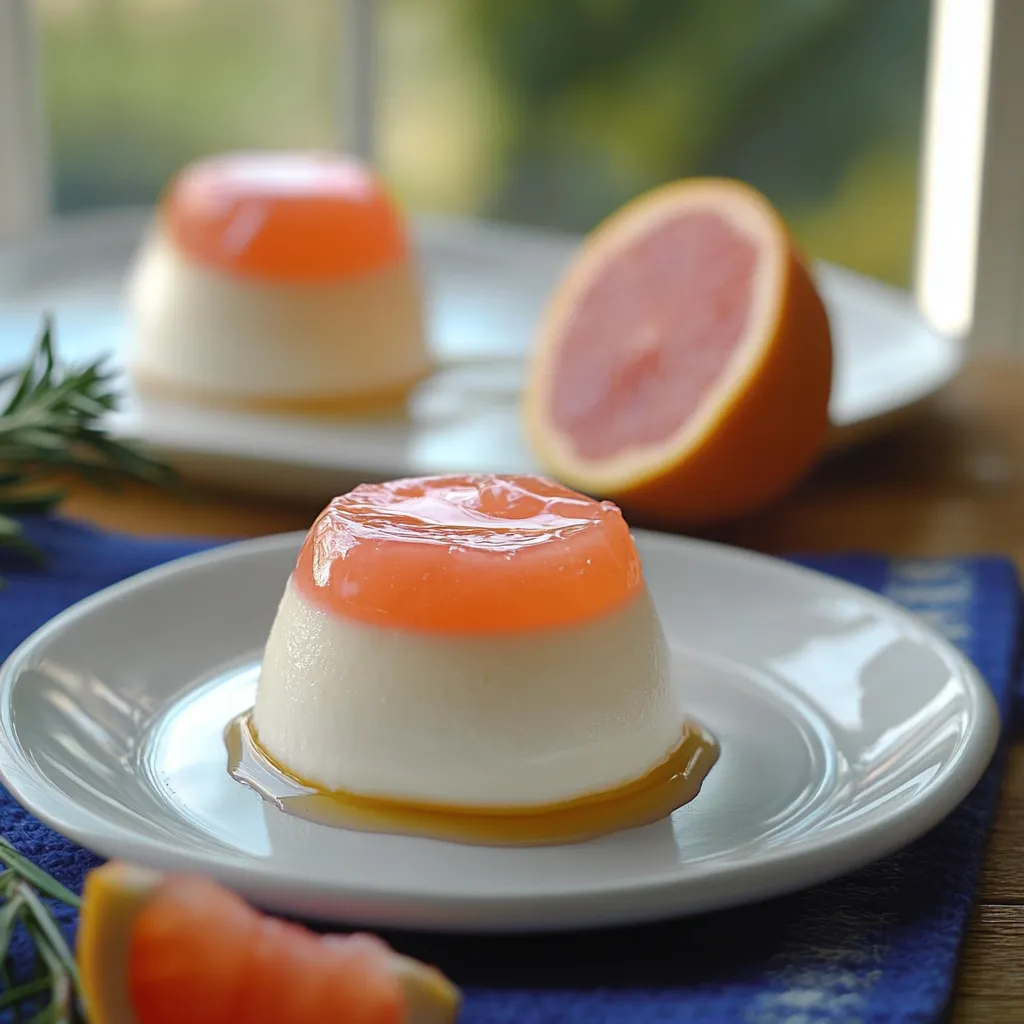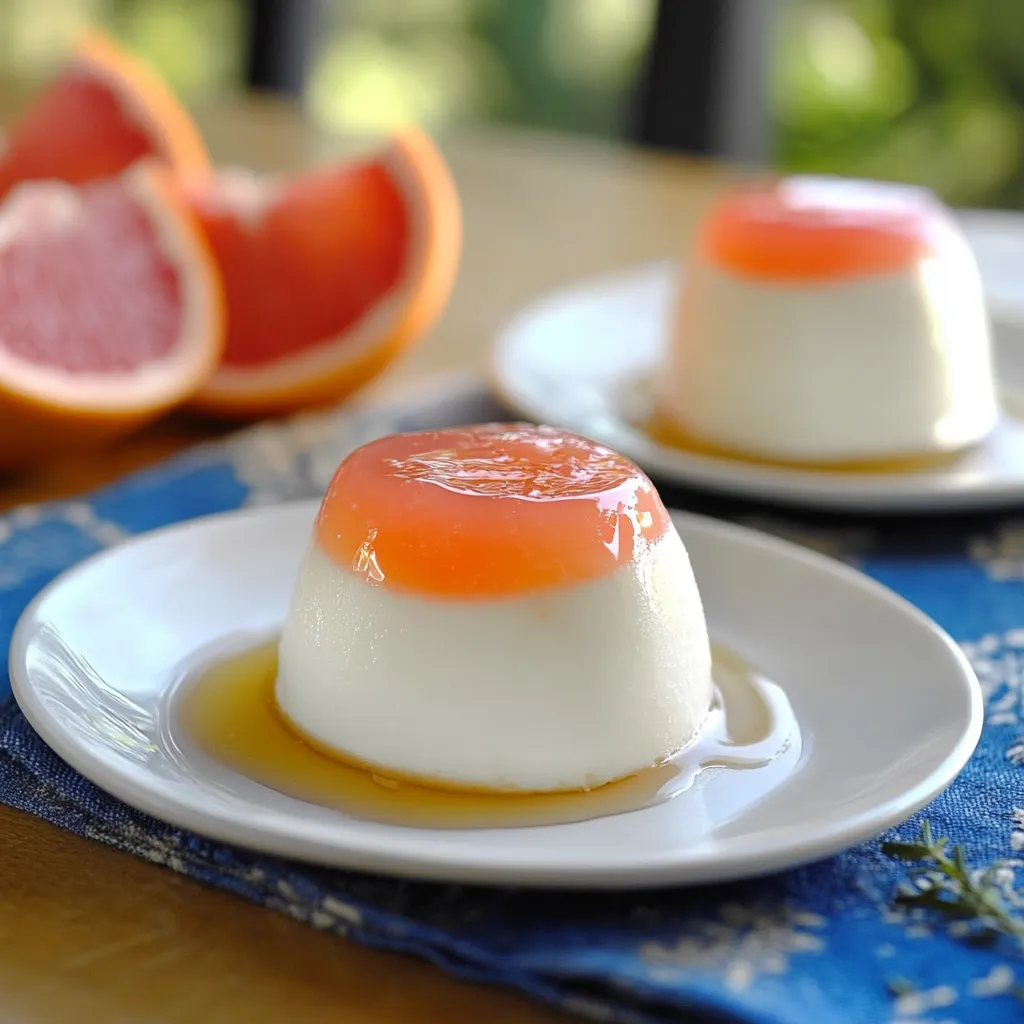 Pin it
Pin it
This rosemary honey panna cotta with grapefruit jelly is a sophisticated dessert that balances creamy richness with bright citrus. The delicate herbal notes from the rosemary infusion complement the honey sweetness, while the tart grapefruit jelly creates a beautiful visual and flavor contrast.
I first made these panna cottas for a dinner party where I wanted to impress without stressing. The beautiful layers and complex flavors had my guests convinced I had spent hours in the kitchen when the active time was actually quite brief.
Ingredients
- Grapefruit: Fresh is essential for that vibrant color and flavor
- Grapefruit zest: Adds depth and intensifies the citrus flavor without additional acidity
- Powdered gelatin: Provides the perfect set for both layers
- Whole milk: Brings richness while keeping the dessert from being too heavy
- Heavy cream: Creates that luxurious mouthfeel that defines panna cotta
- Fresh rosemary: Infuses a subtle aromatic quality that elevates this dessert
- Honey: Adds natural sweetness with more complexity than plain sugar
Step-by-Step Instructions
- Prepare the molds:
- Lightly grease three pudding molds with a drop of neutral oil using a paper towel to remove excess. This minimal greasing helps the desserts release without affecting flavor.
- Create the grapefruit jelly:
- Juice the grapefruit and warm it with the zest to extract maximum flavor. The brief heating process intensifies the citrus oils without cooking away the fresh flavor. Strain thoroughly pressing to extract all juice as this will be your beautiful bottom layer.
- Set the jelly layer:
- Bloom gelatin properly in cold water before melting for a smooth texture. Distribute the jelly mixture evenly among molds and refrigerate until completely set which takes patience but ensures clean layers. The acid in citrus can sometimes affect gelatin setting so adequate chilling time is crucial.
- Infuse the dairy:
- Combine milk and cream then warm just until steaming not boiling. Chopping the rosemary increases surface area for better flavor extraction during the steeping process. Let the mixture steep covered for the full 30 minutes for balanced herbal notes.
- Complete the panna cotta layer:
- Strain out all rosemary pieces for a silky smooth texture. Add honey to taste considering the tartness of the grapefruit layer. Bloom and melt gelatin carefully before incorporating into the dairy mixture ensuring no grainy texture develops.
- Unmold with confidence:
- The hot water bath trick makes unmolding stress free. Pay attention to the timing suggested based on your specific molds thickness. Run a thin knife around the edge before inverting onto a serving plate for the perfect release.
 Pin it
Pin it
The moment my spoon broke through both layers for the first bite remains etched in my memory. The honey rosemary combination was inspired by my favorite childhood tea that my grandmother would make when I was feeling under the weather. Adding the grapefruit element transformed a nostalgic flavor into something sophisticated and new.
Achieving the Perfect Set
The amount of gelatin you use dramatically affects the final texture of your panna cotta. For a more traditional creamy slouching panna cotta that gently relaxes on the plate use the lesser amount of gelatin. If youre creating a taller mold or want a more definitive shape opt for the larger quantity. The grapefruit layer requires less gelatin since it will be supported by the firmer panna cotta layer above it. Remember that overheating gelatin can reduce its setting power so always melt it gently.
Flavor Variations
This recipe framework welcomes creative adaptation. Replace rosemary with lavender or thyme for different aromatic notes. The grapefruit can be swapped for blood orange in winter or ripe peaches in summer. Consider infusing the cream with cardamom pods or star anise for a more exotic profile. The honey variety matters too try buckwheat honey for a deeper flavor or orange blossom honey to complement the citrus notes. Whatever substitutions you make maintain the same proportions of gelatin to liquid for consistent results.
Serving Suggestions
These elegant desserts need minimal accompaniment. A small shortbread cookie provides textural contrast without competing with the delicate flavors. For a more substantial dessert plate add a quenelle of lightly sweetened whipped cream or a small scoop of vanilla bean ice cream. Fresh berries particularly raspberries or blackberries offer a welcome burst of color and complementary flavor. For special occasions consider garnishing with a small sprig of fresh rosemary and a curl of candied grapefruit peel to hint at the flavors within.
 Pin it
Pin it
This recipe captures the essence of elegance and ease, perfect for celebrating both simple and special occasions alike.
Frequently Asked Questions
- → Can I make this dessert in advance?
Yes! This dessert is perfect for making ahead. The panna cotta needs time to set properly, so preparing it the day before serving is ideal. It will keep well refrigerated for up to 3 days.
- → What can I substitute for grapefruit?
If grapefruit isn't available or to your taste, you can substitute with blood orange, regular orange, or even lemon. Each will provide a different flavor profile but will work well with the rosemary-honey base.
- → Do I need special equipment to make this?
No special equipment is required. Standard ramekins or pudding molds work perfectly. If you don't have these, small glasses or cups can be used, though you may need to serve directly in them rather than unmolding.
- → Can I use vegetarian gelatin alternatives?
Yes, agar-agar or vegetarian gelatin can be substituted. Use about 1 teaspoon of agar-agar powder for each teaspoon of gelatin, but note that the setting time and texture may differ slightly.
- → Why is my panna cotta not setting properly?
This could be due to insufficient gelatin, not allowing enough cooling time, or issues with blooming the gelatin. Make sure to follow the exact measurements, properly bloom the gelatin in cold water, and allow at least 4-6 hours (preferably overnight) for setting.
- → Can I use different herbs instead of rosemary?
Absolutely! Thyme, lavender, or basil can be excellent alternatives that pair beautifully with honey and citrus. Adjust quantities based on the herb's strength - lavender and thyme are quite potent and may require less than the recipe calls for with rosemary.
